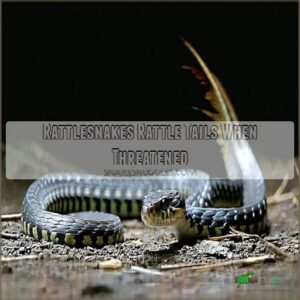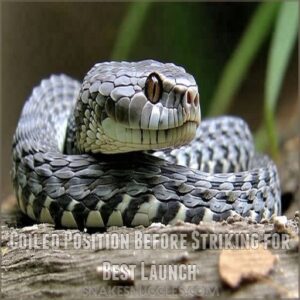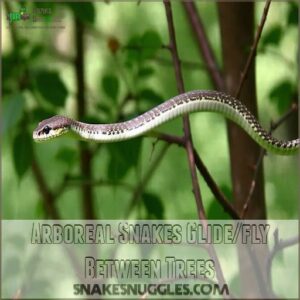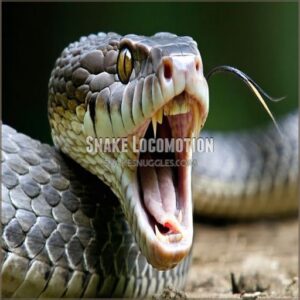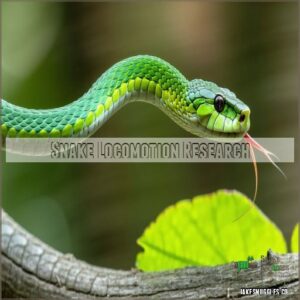This site is supported by our readers. We may earn a commission, at no cost to you, if you purchase through links.

Technically, snakes can’t leap like frogs, but they can cover a surprising distance.
Rattlesnakes, for instance, can strike up to half their body length.
Imagine a three-foot snake launching at you from a foot and a half away!
Meanwhile, some tree-dwelling snakes, like those in the Dendrelaphis genus, take it up a notch by gliding between trees, covering astonishing distances up to 300 feet.
It’s a fascinating world of snake motion, revealing nature’s adaptability at its finest.
Curious about more snake surprises?
Table Of Contents
- Key Takeaways
- Rattlesnake Striking
- Snake Mobility
- Snake Locomotion
- Michelle Graham’s Experiments
- King Cobras and Lethal Venom
- Snake Locomotion Research
- Frequently Asked Questions (FAQs)
- How far can a snake jump?
- How far can a rattlesnake jump?
- Can a snake jump off the ground?
- How do snakes measure jumping distance?
- How far can a snake strike?
- What is a jumping viper?
- How far can a snake lunge?
- How far can rattlesnakes leap?
- Can snakes jump from the ground?
- What to do if a snake jumps at you?
- Conclusion
Key Takeaways
- You’ll find that snakes don’t jump like frogs; they use various methods to cover ground quickly.
- Rattlesnakes strike, not jump, up to half their body length; this is a fast, powerful defensive move.
- Some tree snakes, like those in the Dendrelaphis genus, glide up to 300 feet between trees.
- While snakes can’t jump in the traditional sense, their unique locomotion methods—slithering, climbing, gliding—allow them to move surprisingly far and efficiently.
Rattlesnake Striking
When you’re dealing with rattlesnakes, it’s important to know that their striking range is about one-third to one-half their body length, making them formidable opponents.
Rattlesnakes are ready to spring from a coiled position faster than a hiccup, with their tails rattling as a warning and fangs exposed.
Strike Range is 1/3 to 1/2 of Snake Body Length
Picture a rattlesnake, perhaps four feet long, striking out from its coiled position, its fangs ready—a display of power and precision.
A snake’s strike distance and accuracy are influenced by its behavior and other factors, including its snake strike distance.
With a strike range of 1/3 to 1/2 of its body length, it relies on muscle to propel itself rapidly.
This instinct allows it to defend or catch prey efficiently, showcasing the remarkable snake jumping ability despite its legless anatomy.
Rattlesnakes Rattle Tails When Threatened
Rattlesnakes have a unique way of saying, "I’m here, watch out!"
When they’re spooked, they shake those iconic tails as a danger signal—a tail-rattling warning that packs a sonic punch.
This behavior, a hallmark of rattlesnake defense, tells predators to back off.
Despite what cartoons might suggest, these snakes aren’t known for their jumping abilities, sticking mostly to striking.
Coiled Position Before Striking for Best Launch
Coiling up like spring-loaded toy, you harness maximum energy before striking.
The coiled position is all about storing power, helping rattlesnakes strike with precision and speed.
You might be surprised to learn that understanding this coiling mechanism can also help you gauge a rattlesnake’s strike distance (optimal strike products).
This sneaky trick lets them navigate easily, maintaining their balance and grip on rough terrains.
It’s a bit like watching nature’s own version of physics at work—truly fascinating!
Fangs Exposed, Ready to Bite When Attacking
Imagine a rattlesnake poised to strike, fangs bared like tiny daggers ready to deliver venom.
With lightning-quick speed, it lunges up to 0.5 feet in just milliseconds.
Defensive bites mightn’t inject venom, unlike predatory strikes from larger snakes that carefully calculate venom delivery for hunting success.
Understanding these behaviors demystifies their defensive mechanisms and strike speed.
Snake Mobility
You might be surprised to learn that snakes don’t jump like frogs; instead, their impressive mobility comes from a combination of slithering, climbing, and even gliding, depending on the species.
Snakes move in a variety of ways.
We’ll explore how these legless reptiles move, covering everything from their powerful muscles to specialized adaptations that let some species seemingly defy gravity.
Snakes Lack Limbs but Are Mobile Through Slithering, Climbing, and Swimming
Despite lacking limbs, snakes impress with their ability to slither seamlessly across landscapes, climb trees like it’s their playground, and swim with grace.
Their belly scales and muscular build are key to this mobility.
Consider these marvels of movement:
- Slithering speeds them over terrain.
- Climbing skills defy gravity.
- Swimming techniques rival aquatic life.
- Adaptive behaviors enhance survival.
Traditional Jumping Impossible Due to Anatomy
Snakes and their jumping antics! You might think they’re leaping champs, but their anatomy doesn’t allow traditional jumps.
Instead, their slithery ways, those impressive muscles, and specialized scales come into play.
They can’t launch like kangaroos, but they surprise with moves that account for a third of their body length.
Stay curious and marvel at these silent movers!
Arboreal Snakes Glide/fly Between Trees
Regarding tree-dwelling snakes, gliding isn’t just a nifty trick—it’s an art form.
These arboreal snakes, with venom as potent as their aerial prowess, take flight between branches like nature’s own trapeze artists.
You’ll find:
- Arboreal snake adaptations let them fly.
- Gliding mechanisms make them airborne.
- Snake flight evolution shows nature’s creativity.
Strong Muscles, Scales, and Belly Grip Enable Climbing
With their incredible muscles, scales, and belly grip, snakes rock the climbing world, scaling walls like they’ve got secret suction cups.
Sure, they’re legless, but that doesn’t stop them from putting Spider-Man to shame.
Arboreal acrobatics take over as they jump and glide between trees, showing off adaptations that allow remarkable feats.
Some species, like the Australian tree-dwelling snakes, have even developed snake jumping behavior.
Check out this table to explore their superpowers.
| Attribute | Function | Species Example | Jumping Ability |
|---|---|---|---|
| Muscles | Provide force for climbing and jumping | King Cobra | Jumps up to 2/3 body length |
| Scales | Enhance grip on vertical surfaces | Tree Python | Expert climbers and gliders |
| Belly Grip | Anchors snake to surfaces | Emerald Tree Boa | Moves swiftly across branches |
| Glide Ability | Evolved for tree-to-tree travel | Flying Snake | Glides up to 300 feet |
So, next time you watch a snake in action, remember: their movement is as crafty as their cunning.
Whether hunting or escaping, their climbing techniques and arboreal movements showcase natural mastery over their environment—no legs required.
Snake Locomotion
Even without limbs, snakes have mastered unique methods of getting around, like gliding between trees or slithering with remarkable agility.
You mightn’t see them taking the gold in the long jump, but they sure know how to cover ground efficiently.
Snakes Exhibit Unique Locomotion Despite Lacking Limbs
Imagine a legless gymnast gliding with grace; that’s a snake for you.
Flying snakes flatten their bodies to soar, while Dendrelaphis species leap astonishing gaps.
Sea snakes, with their paddle-like tails, swim with ease.
Each movement—from climbing trees to launching across spaces—reveals fascinating adaptations, showcasing the remarkable evolution of snake movement and their interactions in the wild.
Tree-dwelling Snakes Use Bridging to Move Between Branches
Ever wonder how tree snakes navigate branches?
They use a clever bridging technique!
These arboreal acrobats grip with their belly scales, then powerfully push off, moving between branches with surprising speed and grace.
Their snake agility is truly remarkable, showcasing amazing arboreal adaptations.
This branch movement is all thanks to their strong muscles and specialized scales.
The habitat impact on their locomotion is clear – they’re masters of their treetop world!
Flying Snakes Flatten Bodies to Glide Up to 300 Feet
Jumping from branch to branch might seem the domain of monkeys, but enter the remarkable world of flying snakes.
These arboreal marvels, like Chrysopelea paradisi, flatten their bodies, gliding gracefully up to 300 feet, with fans even purchasing flying snake distance-tracking gear Flying Snake Distance to measure their aerial feats.
By leveraging air resistance, they execute a stunning aerial ballet:
- Flattened bodies for lift
- Ridge for stability
- Gliding for prey capture
- Evading predators with style
Michelle Graham’s Experiments
In Michelle Graham’s experiments, you get to observe the fascinating jumping behavior of Dendrelaphis snakes, capturing their slinking and sudden launching moves.
Her research reveals these unique locomotion techniques and also sheds light on the broader spectrum of animal diversity.
Graham’s Experiments Captured Dendrelaphis Jumping Behavior
Michelle Graham’s experiments reveal that Dendrelaphis, often mistaken for amateur acrobats, showcase unique jumping abilities.
They glide up to 300 feet, leveraging powerful muscles and scales.
While venom remains their ace up the sleeve for prey, these snakes outpace others in striking speed.
Graham’s research shines a light on their fascinating biomechanics, offering insight into the evolution of snake jumping and gliding.
| Feature | Details | Impact |
|---|---|---|
| Jump Distance | Up to 300 feet | Expands hunting range and escape routes |
| Locomotion Type | Gliding | Efficient prey capture |
| Biomechanics | Muscles and belly grip | Supports powerful launches |
| Venom Strategy | Reserved for larger bites | Enhances predation efficiency |
Jumping Behavior Involves Slinking and Launching
Imagine you’re a snake, poised and ready, coiling tight before you launch yourself across a gap.
Your slinking movement turns into a sudden leap, a proof of your powerful muscles and perfect scale grip, all set for a strike if necessary.
That’s the Dendrelaphis’s art—demonstrating snake locomotion with such force that it questions traditional jumping!
Investigating Locomotion Sheds Light on Animal Diversity
Exploring snake locomotion unravels the vast tapestry of animal diversity, with movements like gliding up to 300 feet revealing evolutionary adaptations.
Research on snake jump distance reveals that various species have unique mechanisms for traversing their environment.
For instance, studying the best snake jump distance products can shed light on the adaptations that enable these movements.
Michelle Graham’s experiments on the Dendrelaphis showcase these intriguing strategies.
Even king cobras, known for their lethal venom, add depth to our understanding of how different species adapt.
Locomotion research illuminates myriad movement strategies, shedding light on snake jump distances and mechanisms.
Research Aims to Understand Reasons Behind Jumping
Research examines why snakes, despite their legless design, exhibit jumping behaviors.
It reveals fascinating evolutionary adaptations that enhance their predator-prey dynamics.
With magnificent snake biomechanics, they defy odds, gliding effortlessly between branches and lunging at impressive speeds.
Understanding these behavioral advantages, from snake jumping power to mechanisms, shows nature’s resourcefulness.
This insight captivates researchers exploring snake jump distance and height within diverse habitats.
King Cobras and Lethal Venom
You’ll discover that king cobras are renowned for their impressive size but also for their incredibly potent venom—a truly deadly cocktail.
Scientists are studying these magnificent and dangerous snakes.
This section explores their unique traits, including their surprisingly long striking distance.
King Cobras Possess Lethal Venom and Unique Traits
Although snakes can’t truly jump, King Cobras surprise with their unique traits and striking capabilities.
With lethal venom and the ability to cover distances quickly, they’re a formidable presence in their habitats.
Their behavior reveals an intriguing mix of gliding and rapid locomotion, offering a fascinating glimpse into the adaptability and evolution of snake species across different environments.
Graham’s Study Explores Evolution of Jumping and Gliding
Michelle Graham’s work reveals the secrets of snake locomotion, delving into how King Cobras leap and glide, despite their fearsome reputation for venom.
By studying flying and Dendrelaphis snakes, Graham exposes evolutionary adaptations in tail shape that aid in jumping.
Her findings illuminate the reasons behind these behaviors, enhancing our understanding of snake jump evolution and snake jumping prowess.
Close Relatives Provide Insight Into Behavior Continuum
Looking at close snake relatives helps unravel their evolutionary history and behavioral adaptations.
You see how gliding techniques and slithering dynamics play out across species.
Flying snakes glide up to 300 feet by flattening their bodies, while Australian Dendrelaphis leap by slinking and launching.
These fascinating behaviors shed light on the snake jumping mechanism, revealing a blend of agility and mystery.
Challenges in Researching These Behaviors
Studying snakes isn’t just a walk in the park.
You’re grappling with venomous cobras and elusive jumping Dendrelaphis.
Observing snakes in nature, especially their jumping mechanism or striking behaviors, isn’t easy.
Ethical considerations limit controlled environments, making capturing rare behaviors tricky.
Data analysis challenges add another layer, as snake jump height and distance fluctuate wildly in unpredictable ways.
Snake Locomotion Research
You might think snakes have a limited range in movement, but research by Graham, building on Socha’s lab work, reveals their surprising locomotion capabilities.
By studying these slithery creatures, researchers gain unique insights into how they’ve adapted to glide, jump, and maneuver through their environments.
Graham Builds on Socha’s Lab Research
You’re standing on the shoulders of giants like Socha’s research as you explore how snakes like Chrysopelea ornata and Dendrelaphis caudolineatus leap and glide.
Graham’s comparative studies reveal these snakes’ evolved survival tricks, including adaptations for snake climbing techniques.
By examining their jumping and gliding, you gain fresh evolutionary insights into their locomotion, uncovering the secrets behind their surprisingly airborne lifestyles.
Snake Locomotion Research Offers Unique Insights
Snake locomotion research reveals a world of fascinating adaptations.
Imagine a flying snake, flattening its body to glide between trees! Or a tree snake, bridging gaps with surprising agility.
These unique movements are the focus of exciting research, revealing how snakes overcome their legless design.
Studying their diverse locomotion helps us understand snake evolution and the incredible variety of life on Earth.
Frequently Asked Questions (FAQs)
How far can a snake jump?
Snakes don’t leap as we do.
Instead, they "slingshot" themselves.
Depending on the species and size, they might cover several feet.
Picture a spring-loaded coil, propelling them forward—or up—into impressive arcs without legs!
How far can a rattlesnake jump?
Rattlesnakes can strike about two-thirds of their body length when coiled, not jumping in the traditional sense.
Typically, this means they may reach up to five feet in a quick defensive move, not an actual jump.
Can a snake jump off the ground?
Imagine a snake trying to leap like a frog—it’s not happening.
Although they can’t jump off the ground, some snakes can use a slingshot-like motion to propel themselves forward, but they’re not airborne jumpers.
How do snakes measure jumping distance?
Ever heard about a coin flip?
Like that, a snake’s "jumping" distance isn’t exactly straightforward.
Instead, they coil, build pressure, and propel forward, measuring the distance covered by their bodies without formal metrics, kind of like nature’s slingshot.
How far can a snake strike?
A snake’s strike distance varies wildly!
It depends on the species and how coiled it is.
King cobras, for example, can strike over nine feet—that’s a long reach!
Smaller snakes? Not so much.
What is a jumping viper?
Despite its name, a jumping viper doesn’t actually jump.
It’s a species of viper known for its quick striking ability.
Found in Central and South America, it uses surprise and speed to catch prey effectively.
How far can a snake lunge?
When a snake lunges, it can cover about one-third to half its body length, depending primarily on its species and size.
This movement is swift and precise, often surprising both prey and potential threats.
How far can rattlesnakes leap?
Rattlesnakes can lunge up to two-thirds of their body length when striking, not exactly leaping, but getting impressively close.
Imagine one stretching out, like a tightly coiled spring snapping straight, aiming perfectly at its target.
Can snakes jump from the ground?
Snakes can’t really jump like you might picture.
Instead, they use powerful body movements to "slingshot" forward.
This quick burst lets them cover ground efficiently, but their entire body doesn’t leave the ground simultaneously.
What to do if a snake jumps at you?
Picture a tense standoff with a snake coiling up for a leap.
First, remain calm and slowly back away, giving it space.
Don’t make sudden moves; instead, retreat smoothly and allow the snake to escape.
Conclusion
Regarding snake behavior, there’s more than meets the eye.
Though snakes don’t jump in the usual sense, they can cover surprising distances through strikes, glides, and clever locomotion.
Rattlesnakes can strike half their body length, and some tree-dwelling serpents glide impressive distances.
This ability gives a whole new meaning to "stretching their limits."
Next time you wonder, "how far can a snake jump?", remember nature’s fascinating adaptations are at play.


